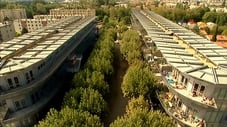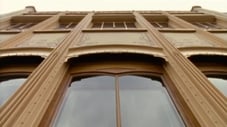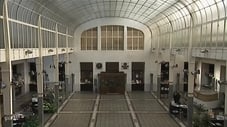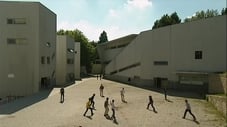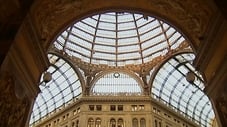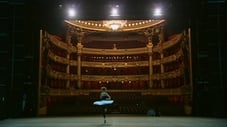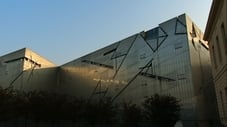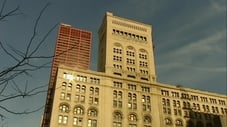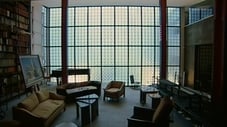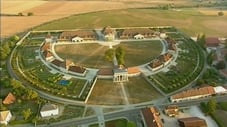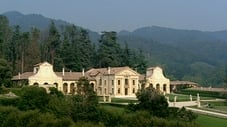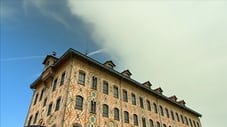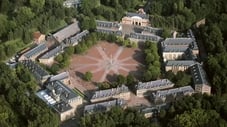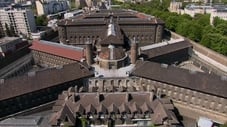
Architectures (1996)
← Back to main
Stan Neumann — Director
Episodes 22
Nemausus 1
In Nîmes, Jean Nouvel conceived a block of tenement houses reminiscent of a cruise liner. An architectural utopia that pokes fun at the truisms of council housing.
Read MoreThe Iron House
In late 19th century Brussels, the Art Nouveau movement was laying the foundations of a new concept in architecture, and Victor Horta was the movement's grand master. Of all his works, the Hotel van Eetvelde features the boldest display of his modernity.
Read MorePierrefonds, the Architect's Castle
Middle Aged castle rebuilt by Viollet Le Duc for the Emperor Napoleon III. A reconstruction that paradoxically opened the way for modern architecture.
Read MoreThe Vienna Savings Bank
At the turn of the last century, Otto Wagner designed one of the first 20th century modern office buildings, representing a radical break with the previous tradition in bank-architecture.
Read MoreThe Siza School
The Portuguese architect Alvaro Siza built Porto's Faculty of Architecture, a mediation on space and light in a futuristic "agora". Alvaro was once a student and still teaches there today.
Read MoreThe Galleria Umberto I
Built in Naples, this is one of the last and largest covered passageways to be constructed in Europe, providing the swan song for a grand invention of 19th century architecture.
Read MoreThe Wind Box
The Fort de France Education Authority is the only example of a contemporary architectural building in Martinique. It is also the only official building to be naturally ventilated by the trade winds. Christian Hauvette has created a totally open building, in which the boundaries between exterior and interior are blurred.
Read MoreThe Garnier Opera
The Garnier Opera by Charles Garnier This is Paris's most prestigious 19th century building, the pinnacle of the "Beaux Arts" style with its ornamented facade, transfigured by the excesses of a theatre-mad architect in the mid-1800s.
Read MoreThe Jewish Museum Berlin
The Jewish Museum in Berlin, by Daniel Libeskind, tackles the emptiness left by the extermination of Europe's Jews during the Second World War. His response is an architecture of absence.
Read MoreThe Auditorium Building in Chicago
At the end of the 19th century, Louis Henry Sullivan, the father of American architecture, built the world's largest opera house, a "democratic" auditorium which was revolutionary in its very conception.
Read MoreThe Glass House
In 1928, Pierre Chareau built the poetic and remarkable Maison de Verre, one of the unique buildings of the 20th century. Inserted into an existing building, the views dissolve through semi-transparent materials, juxtaposing metal and glass, almost taking it into the realms of Surrealism.
Read MoreThe Abbey Church of Saint Foy at Conques
Built in 1050, the Abbey is one of the foremost pilgrim churches of the Christian world. Rational, svelte and light-filled Romanesque architecture that flies in the face of cliches.
Read MoreThe Royal Saltworks of Arc-et-Senans
The visionary architect Claude Nicolas Ledoux, one of the earliest exponents of French Neoclassical design, built a monumental factory for the king of France at the end of the 18th century. It is pragmatic and utopian, an aesthetic revolution.
Read MoreJean Prouvé's House
In 1953, while going through his worst life-crisis, French designer Jean Prouvé built "his" house. Designed in haste, it embodies his most innovative ideas.
Read MoreThe Reception and Congress Building in Rome
In the most ambitious of the Mussolini regime's buildings, the leader of Italy's modern movement Adalberto Libera attempted the impossible combination of fascism with modernity. It reflects Libera's great ability to design ambiguously in a space, metaphysical language that sits on a knife-edge between modernism and neo-classicism.
Read MoreThe Villa Barbaro
By inventing the villa, a new type of housing, in 1550, Palladio sought to combine aesthetics with utility. This rigorous and innovative approach was to have a lasting influence on Western architecture.
Read MoreThe Menier Chocolate Factory
The Menier factory at Noisiel, outside Paris, was the largest chocolate factory in the world between 1870 and 1914. Throughout its three successive states, it tells the story of a veritable laboratory of industrial architecture in the second half of the 19th century.
Read MoreThe Pyramid of Pharoah Djoser at Saqqara
The Djoser pyramid, the work of legendary architect Imhotep, is the oldest in Egypt, and bears witness to the first steps of architecture as a scholarly pursuit. It was a revolution when built in 3000 BCE, born out of a desire to perpetuate tradition.
Read MoreThe German Pavilion in Barcelona
How and why did this minimalist structure end up embodying 20th century modernity? Between rigor and free form, Ludwig Mies van der Rohe's first masterpiece is a poetic work of spatial flow and intervals.
Read MoreThe Citadel de Lille
Vauban's "Queen of the citadels" was the model for military construction all over France. Built between 1668 and 1671, its exacting and simple design has made it a source of inspiration for major contemporary architects.
Read MoreThe Van Nelle Factory in Rotterdam
A cross between Taylorism and Bauhaus, the Van Nelle factory at Rotterdam was built between 1926 and 1931. Designed by the architects Jan Brickman and Leendert Van der Vlugt, the factory is the most important and the most accomplished example of industrial architecture in the modern movement.
Read MoreThe Sante, a Prison in Paris
La Sante prison (1861-1867) is a unique and impressive work of architecture. At the cutting edge of reflections on imprisonment, it was at the time the ultimate "modern prison", the stone embodiment of 19th century penitentiary obsessions.
Read More